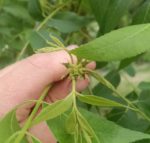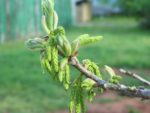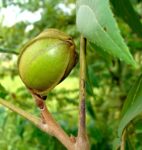The Other Best Time to Plant Pecans
After discovering a small, mature, and very neglected pecan orchard on our new homestead some years back, the saying that the ‘best time to plant a tree was 20 years ago’ never rang truer. February is an important month for pecans and many other fruit and nut trees that thrive in our area. It’s my last chance to collect scions for grafting and my last chance to get bare-root trees in the ground to shore up production from my aging trees. All efforts hinging on Old Man Winter’s rarely graceful exit.
Bare-Root Stock is Ideal to Plant Pecans
We lean towards planting bare-root trees (when we can find them) because they are usually less expensive (no container, no growing medium, easier to ship), quicker to adapt and grow, easier to prune to the desired fruit-or-nut-bearing shape, and the specialized nurseries deal in a wider selection of cultivars.
The “Bare” Minimums
If you are new to planting bare-root stock, there are a few ‘bare’ minimums in their handling and planting that should not be overlooked.
Storage
These are dormant trees and to keep them that way, they should be kept in a cool and dark space until planting. Planting on a sunny day? Keep them in the shade until their new home is dug.
Timing
Maybe you are all fancy pants and outfitted like a commercial grower, but most of us won’t be able to keep unplanted trees under ideal conditions to keep them dormant or from going into shock. Get them in the ground.
Planting
Keep the root ball moist and soak it for 3 hours before planting. Dig the hole twice as wide as the root ball and deep enough to leave the crown and any grafts exposed after backfilling. Create a cone of native soil for the roots to rest on, still leaving the crown and any grafts above grade. Backfill with native soil and give it a soak.
For a comprehensive list of tips and planting instructions for all fruit and nut trees, try hopping on over to this article featuring Agrilife Extension fruit specialist, Dr. Larry Stein.
Pollination is Key
Pecan trees are monoecious. This means that they produce separate male and female flowers on the same plant. Male flowers are located on 4-5 inch long catkins, while female flowers are small, yellowish-green, and grow on spikes at the tips of shoots.
 Female flowers grow on the tips of shoots |
 Male flowers are called catkins |
Pecan are wind pollinated. The pollen is blown from male flowers called catkins to female flowers called nutlets. On most varieties, the pollen is not shed at the same time that the nutlets become receptive.
This means that you need two flowering types:
- Type I, or protandrous, pecans are those in which the catkins appear first.
- Type II, or protogynous, pecans are those in which the female nutlets become receptive before the catkins begin to shed pollen.
You can find the list of recommended varieties and their pollination type using this link.
If you have a notion to use some of the abundant native trees as pollinators, you are in luck, sort of. I was hard pressed to find any information regarding the pollinator types for native trees so I reached out to Dr. Monte L. Nesbitt, Extension Program Specialist at Texas A&M AgriLife Extension.
He says, “Native pecans are a mix of Type I and Type II. Both exist in any group of native trees. They also vary a great deal in the timing of their respective flower appearance and maturity. So you can have early, mid and late Type II and early, mid and late Type I. It’s very asynchronous, although generally falling in the time period of late March to mid May.”
Sounds like a roll of the dice to rely on as a specific pollinator unless you have a large stand nearby.
Upgrade Your Native
We have had pretty good luck with removing smaller natives (up to 12” diameter) at the base and then selecting a suitable new stalk to graft on an improved variety the next season. These Texas trees are tough as nails and will absolutely try to send up multiple, new trunks after cutting one down. Sometimes we leave 2 or 3 stalks for grafting and remove all but the best graft in late spring.
If you have the luxury of some small natives on your property or you decide to let a squirrel treasure seedling go to root, give grafting a go. It’s not as daunting as you think. You have just enough time left this year to cut scions. Texas A&M AgriLife Extension has the whole process laid out for you right here. They also have a video on YouTube.
Help When You Need It
As always, the Travis County Master Gardner Help Desk volunteers are eager to help with your plant questions or concerns. If including photos, take one close-up showing the detail or problem, take another of the whole plant, and please make sure your photo is in focus. I’m sure your plant will sit still for another one.
Additional Resources
Backyard Fruit and Nut Production Tips for Travis County
Recommended Fruit and Nut Varieties for Travis County
Webinar – Home Fruit Production with Dr. Larry Stein. Broadcast Date 9/14,2021. Dr. Stein’s area of research has been on production horticulture developing best management practices for pecans, he is also an editor of the Texas Pecan Handbook
Improved Pecans from Aggie Horticulture (co-authored by Dr. Stein)
Native Pecans from Aggie Horticulture (also co-authored by Dr. Stein)
Texas Inlay and Four Flap Grafting which includes a link to a YouTube video
About Ray Prewitt

Ray’s green thumb points straight back to his mother and credits his great-grandmother for his love of pickles and occasional use of a sun bonnet while gardening. He is an actor and former aircraft salesman. He and his partner have a large vegetable garden for the kitchen and for sharing, but mostly he is trying to perfect the pickled pepper.

